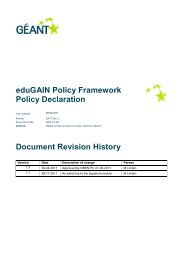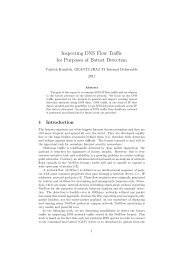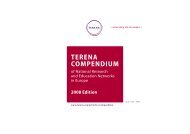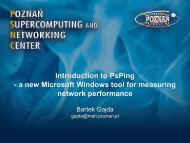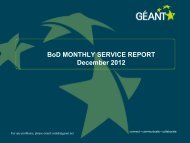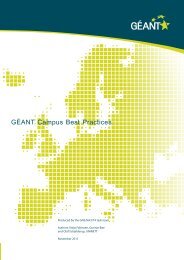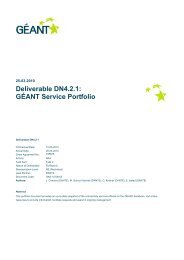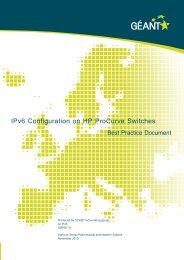Guide to configuring eduroam using a Cisco wireless controller Best ...
Guide to configuring eduroam using a Cisco wireless controller Best ...
Guide to configuring eduroam using a Cisco wireless controller Best ...
You also want an ePaper? Increase the reach of your titles
YUMPU automatically turns print PDFs into web optimized ePapers that Google loves.
http://www.cisco.com/en/US/tech/tk722/tk809/technologies_configuration_example09186a008<br />
08714fe.shtml<br />
3) DNS discovery. The access point uses the domain name (provided by DHCP) in conjunction<br />
with the unit name “CISCO-CAPWAP-CONTROLLER” or “CISCO-LWAPP-CONTROLLER”<br />
and then looks this up in the DNS. For example, the domain name “uninett.no”, in conjunction<br />
with “CISCO-CAPWAP-CONTROLLER” gives “CISCO-CAPWAP-CONTROLLER.uninett.no”.<br />
Of course, this requires the <strong>controller</strong> <strong>to</strong> be first registered in the DNS. It is recommended that<br />
both the “CISCO-CAPWAP-CONTROLLER” and “CISCO-LWAPP-CONTROLLER” names be<br />
entered in the DNS, since older access points will not recognise CAPWAP in connection with<br />
initial association (until they have been upgraded).<br />
Configure a VLAN with an IPv4 subnet large enough for all access pointaccess<br />
points with realistic growth potential. Configure DHCP support for this subnet.<br />
Use Layer 3 communication between the access points and the <strong>controller</strong>.<br />
All ingoing and outgoing traffic in the access point subnet shall be blocked<br />
except:<br />
- If CAPWAP: UDP 5246 and UDP 5247 <strong>to</strong>/from access point VLAN<br />
- If LWAPP: UDP 12222 and UDP 12223 <strong>to</strong>/from access point VLAN<br />
- DNS – UDP 53 (may be restricted <strong>to</strong> relevant DNS servers)<br />
1.6 Users<br />
For ISC DCHP, enter:<br />
option domain-name "yourdomain.no";<br />
...in the shared network specification for the subnet or globally. <strong>Cisco</strong> access points do not<br />
support an option containing several domain specifications, such as<br />
option domain-name "uninett.no win.uninett.no home.uninett.no";<br />
Using RADIUS and dynamic VLAN assignment (AAA override), it is possible <strong>to</strong> grant different groups<br />
access <strong>to</strong> different subnets or VLANs <strong>using</strong> the same SSID (for example “<strong>eduroam</strong>”). It is desirable <strong>to</strong><br />
separate users in<strong>to</strong> different subnets <strong>to</strong> be able <strong>to</strong> use filters <strong>to</strong> regulate the level of access of external<br />
and internal services.<br />
As a rule, a typical educational institution will have at least the following user groups:<br />
• Employees<br />
• Students<br />
• Guests<br />
One may also wish <strong>to</strong> create a distinction between different types of employees, students and guests.<br />
The configuration of FreeRADIUS in connection with dynamic VLAN assignment is described in detail<br />
in Chapter 9 of UFS112 [1].<br />
The same VLAN should not be used for <strong>wireless</strong> access as for wired network access, primarily for<br />
security reasons. It may be difficult <strong>to</strong> trace both faults and breaches of ICT rules and security if one is<br />
11



